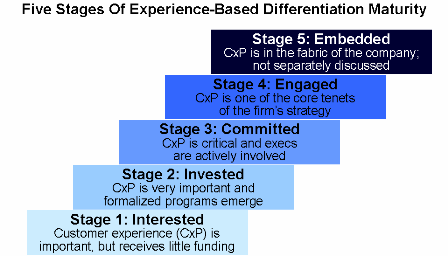
Here’s a little bit of what goes on in each of the 5 stages (excerpt from the article)
- Stage 1 (Interested): In the first level of EBD maturity, organizations begin to believe that customer experience is an important part of their business. They start undertaking a number of different efforts without making any major investments, attempting to get a handle on the current situation. There’s a flurry of uncoordinated activity and no real leadership for customer experience activities.
- Stage 2 (Invested): Companies enter into the second level of EBD maturity after they recognize that customer experience is worthy of a significant investment; in both capital and key personnel. So the approach to customer experience becomes more organized with an intensified focus on fixing problems.
- Stage 3 (Committed): In the third level of EBD maturity, firms are embracing customer experience because they understand the specific impact it has on business results like growth and profitability. The effort is no longer isolated to a few groups as customer experience becomes a major transformational effort across the organization. Instead of just trying to fix problems, the focus turns to redesigning processes.
- Stage 4 (Engaged): When companies enter into the fourth level of EBD maturity, customer experience is a key component of everything they do. Instead of re-engineering processes, the focus turns to designing break-through experiences and solidifying the culture. There’s significant emphasis on employee engagement and companies become much less dependent on a centralized customer experience group.
- Stage 5 (Embedded): At the highest level of EBD maturity, which can take companies several years to achieve, customer experience is deeply ingrained throughout the organization. Just about every employee feels ownership for maintaining the culture. The executive team no longer focuses on change but views itself as keeper of the customer-centric culture, which is viewed as a critical asset.
You can review the complete article here:
https://experiencematters.wordpress.com/2008/09/18/the-customer-experience-journey/
